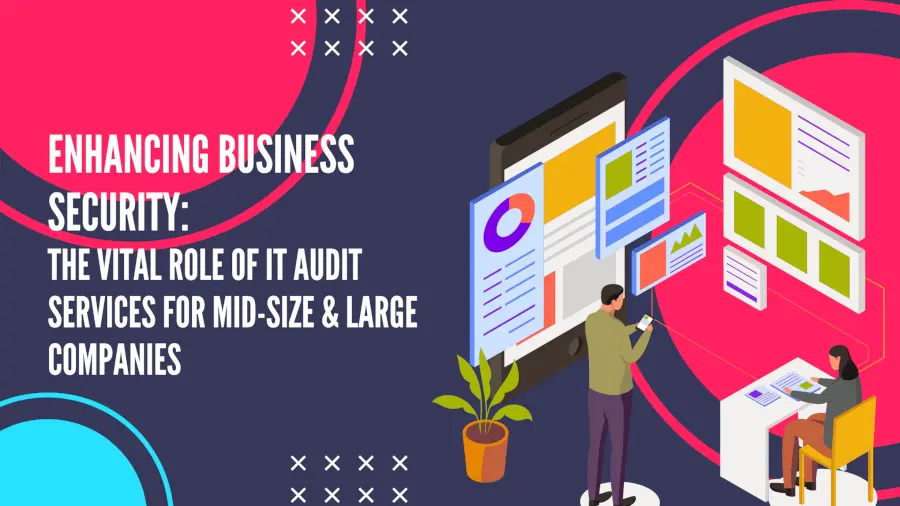There is no debate, technology reigns supreme and companies of all shapes and sizes are harnessing its potential to revolutionize their operations and stay ahead of the pack. But for mid-size and large companies with annual revenues reaching $5 million and beyond, the stakes are even higher. As they scale and expand, they encounter a whole new set of challenges—think information security, regulatory compliance, and risk management. Enter the unsung hero of the business world: IT audit services.
IT audit services are like having a super-sleuth detective who swoops in and meticulously examines your organization’s technology systems, controls, and practices. Their mission? To identify vulnerabilities, assess risks, ensure compliance with rules and regulations, and keep your IT infrastructure in tip-top shape. Now, you might be thinking, “Do we really need another process or expense in this tough economic climate?” Trust me, my friend, the answer is a resounding YES! IT audits are not just a box-ticking exercise; they hold the keys to unlocking vital insights that can propel your business forward, bolster security, protect sensitive data, and ultimately make your operations rock-solid.
We’re going to dive deep into the world of IT audit services and explore why they are absolute game-changers for mid-size and large companies. We’ll unravel the incredible benefits they bring to the table, such as spotting and neutralizing sneaky IT risks, evaluating controls and governance like true business ninjas, fortifying data security and privacy, and turbocharging your IT infrastructure. We’ll also unravel the mysteries of legal compliance, showing you how IT audits can keep you on the right side of the law and safeguard your reputation.
But that’s not all! We’ll equip you with the tools to conquer risk management like a seasoned pro. Discover how IT audits help you identify potential hazards, implement smart controls to mitigate risks, and showcase your savvy risk management strategies to stakeholders. You’ll be a risk-slaying hero in no time!
Don’t miss out on the chance to revolutionize your business and unlock a future of success and resilience!
- Understanding IT Audit Services
- Benefits of IT Audit Services
- Compliance and Legal Requirements
- Risk Management and Mitigation
- The IT Audit Process
- Selecting an IT Audit Service Provider
- Conclusion

Understanding IT Audit Services
Now let’s start by diving into the realm of IT audit services and unravel what the heck it actually means. We’ll break it down into simple terms, so you can grasp this critical aspect of business growth. Let’s get started!
What are IT Audit Services?
An Information Technology (IT) Audit is the thorough examination and evaluation of an organization’s information technology infrastructure, applications, data use and management, policies, procedures and operational processes against recognized standards or established policies.
Tantalizingly put, IT audit service providers can be likened to the superheroes of the business world. The trusted few that step into a business to assess and evaluate a company’s technology systems, controls, and practices. Their mission is to identify vulnerabilities, assess risks, and ensure the strength of your IT infrastructure. They should leave no stone unturned, providing you with the peace of mind that your business is secure and compliant.
Objectives and Scope of IT Audits
So, why do IT audits matter? The objectives are clear-cut: to evaluate the effectiveness of your information systems and infrastructure, assess data security and privacy measures, scrutinize IT governance and controls, and ensure compliance with regulations. It’s like having a comprehensive checklist to keep your tech game strong and your business on track.
Key Components and Areas Covered:
IT audits encompass various critical areas, all of which are essential for a thorough examination:
- Information Systems and Infrastructure: Your protocols, software agreements, and work flows are put under the microscope to evaluate their reliability, performance, and capacity to handle your business needs.
- Data Security and Privacy: Protecting your company’s sensitive information, trade secrets, and customer data is of utmost importance. These aspects of your business need to be safeguarded from unauthorized access and that you comply with privacy regulations.
- IT Governance and Controls: No one likes the word compliance. In fact, this simple word conjures up feelings of anxiety, striking fear in the most hardened of business veterans. Auditors assess your policies and procedures to determine their effectiveness. They ensure that roles and responsibilities are clearly defined, and proper controls are in place.
- Compliance with Laws and Regulations: IT audits should offer more than a double-checking of regulations. that your business adheres to industry-specific regulations and relevant laws, minimizing legal risks.
Now that we’ve gained a solid understanding of IT audit services, it’s time to explore the exciting benefits they bring to the table. Get ready to bolster your business security and unlock a world of possibilities!

Benefits of IT Audit Services
By conducting thorough assessments, IT audits offer valuable insights and opportunities for improvement. Here are some key benefits that can be enjoyed by those willing to take the plunge:
Identifying and Assessing IT Risks
1. Cybersecurity Threats and Vulnerabilities: IT audits help identify potential risks and vulnerabilities in your systems, allowing you to proactively address security gaps and protect against cyber threats.
- Example: Assessing the effectiveness of firewall configurations and intrusion detection systems to prevent unauthorized access.
2. Data Breaches and Potential Impact: By evaluating data handling practices, IT audits help identify weak points that could lead to data breaches, enabling you to take preventative measures.
- Example: Assessing encryption protocols, access controls, and employee training to safeguard sensitive customer data.
3. Operational Disruptions and System Failures: IT audits assess the reliability of your systems and infrastructure, helping you identify potential weaknesses that may lead to operational disruptions or system failures.
- Example: Evaluating backup and recovery procedures to ensure business continuity in the event of system failures or disasters.
Evaluating IT Controls and Governance
1. Effectiveness of IT Policies and Procedures: IT audits evaluate the adequacy and effectiveness of your IT policies and procedures, ensuring they align with industry best practices and regulatory requirements.
- Example: Assessing the implementation and enforcement of password policies and user access management.
2. Segregation of Duties and Access Controls: By reviewing access controls and segregation of duties, IT audits help prevent unauthorized activities and reduce the risk of fraud or misuse of resources.
- Example: Verifying that employees have appropriate levels of access privileges based on their roles and responsibilities.
3. Change Management and System Development Processes: IT audits assess change management processes and system development practices to ensure they are well-defined, documented, and follow industry standards.
- Example: Evaluating the testing and approval procedures for software updates and changes to minimize the risk of system failures or errors.
Enhancing Data Security and Privacy
1. Protecting Sensitive Information from Unauthorized Access: IT audits help identify vulnerabilities in data storage, transmission, and access controls, ensuring sensitive information remains protected from unauthorized access.
- Example: Evaluating encryption protocols for confidential customer data transmitted over networks.
2. Ensuring Compliance with Data Protection Regulations: IT audits ensure your business meets regulatory requirements related to data protection, privacy, and security, reducing the risk of non-compliance penalties.
- Example: Assessing data retention practices to ensure compliance with relevant data protection regulations.
Improving IT Infrastructure and Systems
1. Assessing System Reliability and Performance: IT audits evaluate the reliability and performance of your IT infrastructure, identifying areas that require improvement to enhance system availability and response times.
- Example: Analyzing server performance metrics and network latency to identify bottlenecks.
2. Identifying Areas for Optimization and Cost Reduction: By assessing IT processes and resource utilization, IT audits help identify opportunities for optimizing workflows, reducing operational costs, and improving efficiency.
- Example: Reviewing software license agreements and usage to identify unused or redundant licenses.
3. Ensuring Business Continuity and Disaster Recovery Plans: IT audits assess the effectiveness of your business continuity and disaster recovery plans, ensuring that critical systems and data can be recovered in the event of disruptions or disasters.
- Example: Testing backup and recovery procedures to validate their effectiveness and minimize downtime.
By leveraging the benefits of IT audit services, your business can strengthen its security posture, improve operational efficiency, and ensure regulatory compliance. These audits serve as a valuable tool for optimizing your IT infrastructure and mitigating potential risks.
See, nothing to be fearful of, right?

Compliance and Legal Requirements
In the business world, compliance with industry-specific regulations and legal frameworks is paramount. IT audit services play a crucial role in ensuring that companies meet these requirements. Let’s delve into this topic in more detail:
Each industry has its own set of regulations and standards that govern how businesses operate. Some common examples include:
- Health Insurance Portability and Accountability Act (HIPAA): Regulates the handling of protected health information in the healthcare industry.
- Payment Card Industry Data Security Standard (PCI DSS): Establishes security requirements for businesses that handle credit card information.
- General Data Protection Regulation (GDPR): Protects the privacy and data of European Union citizens.
- Sarbanes-Oxley Act (SOX): Mandates financial reporting standards and internal controls for publicly traded companies in the United States.
Understanding the specific regulations and standards applicable to your industry is vital for ensuring compliance. After all, compliance with legal and regulatory frameworks serve several important purposes:
- Avoiding Legal Consequences: Failure to comply with regulations can lead to legal consequences, such as fines, penalties, or even legal action.
- Protecting Customer Trust: Compliance with privacy and data protection regulations helps maintain customer trust and protects sensitive information.
- Mitigating Business Risks: Compliance minimizes the risk of data breaches, fraud, and other security incidents that can damage a company’s reputation and financial stability.
- Promoting Fair Business Practices: Regulations ensure fair competition and ethical business practices, fostering a level playing field for all industry participants.
IT audit services play a vital role in ensuring compliance with legal and regulatory requirements. They provide an independent assessment of an organization’s compliance posture and identify areas of non-compliance or potential risks. Here’s how IT audits contribute to compliance:
- Evaluating Controls and Processes: IT audits assess the effectiveness of controls, policies, and procedures implemented to meet regulatory requirements.
- Identifying Gaps and Vulnerabilities: Auditors identify gaps in compliance and vulnerabilities that could expose the organization to risks.
- Providing Recommendations: IT audit reports include recommendations for improving compliance, enhancing controls, and addressing identified gaps.
- Assessing Data Protection Measures: Audits evaluate data protection measures to ensure compliance with privacy regulations and secure handling of sensitive information.
IT audits cover various compliance areas, depending on the industry and specific regulations. Some common areas of impact include:
- Data Security and Privacy Compliance: Ensuring the protection of sensitive customer data, secure data storage, encryption practices, and access controls.
- IT Governance and Internal Controls: Assessing the effectiveness of IT policies, segregation of duties, change management processes, and adherence to industry standards.
- Business Continuity and Disaster Recovery: Evaluating the readiness of the organization to handle disruptions, implement disaster recovery plans, and maintain critical systems.
- Record-Keeping and Audit Trails: Reviewing documentation practices, record-keeping processes, and audit trails to demonstrate compliance and accountability.
By conducting comprehensive IT audits, businesses are able to ensure compliance with the relevant legal and regulatory requirements, mitigate unnecessary risks, and maintain a strong ethical standards. What you do think? Worth it?

Risk Management and Mitigation
Effectively managing and mitigating risks is crucial for the long-term success and stability of businesses. IT audit services play a significant role in identifying and mitigating IT-related risks. Let’s explore this topic in more detail:
Identifying IT Risks and Potential Impact on Business Operations
To effectively manage risks, it is essential to identify and understand potential IT risks and their potential impact on business operations. Here are some key considerations:
- System Vulnerabilities: Assessing the vulnerabilities in IT systems and infrastructure that could be exploited by cybercriminals or result in operational disruptions.
- Data Breaches: Identifying the risk of unauthorized access, theft, or loss of sensitive data, which can have severe financial and reputational consequences.
- Technological Dependencies: Evaluating the risks associated with dependence on specific technologies, software, or infrastructure that may become obsolete or experience failures.
- Regulatory Non-Compliance: Recognizing the risks associated with failing to comply with industry-specific regulations, which can result in legal consequences and reputational damage.
Understanding these risks and their potential impact is crucial for effective risk management.
Implementing Controls to Mitigate Identified Risks
Once risks are identified, implementing controls is essential to mitigate their potential impact. Here are key strategies for risk mitigation:
- Security Measures: Implementing robust security measures, such as firewalls, encryption, intrusion detection systems, and access controls, to protect systems and data from unauthorized access and breaches.
- Backup and Recovery: Establishing regular data backup procedures and disaster recovery plans to minimize the impact of system failures or data loss.
- Training and Awareness: Providing regular training and awareness programs to educate employees about cybersecurity best practices and the importance of data protection.
- Continuous Monitoring: Implementing systems and processes for continuous monitoring of IT infrastructure, promptly detecting and responding to potential security incidents or system vulnerabilities.
Implementing these controls helps reduce the likelihood and impact of IT risks on business operations.
Role of IT Audit in Assessing Risk Management Strategies
- Risk Assessment: IT audits assess the organization’s risk management framework, including the identification, analysis, and evaluation of risks, to ensure they align with business objectives.
- Control Evaluation: Auditors review the design and implementation of controls to mitigate identified risks, assessing their effectiveness and adequacy.
- Gap Identification: IT audits identify any gaps or weaknesses in risk management strategies, providing recommendations for improvement and strengthening controls.
- Compliance Verification: Auditors verify that risk management practices comply with applicable laws, regulations, and industry standards.
By conducting regular IT audits, organizations can gain valuable insights into their risk management strategies and make informed decisions to mitigate potential risks effectively.
Case Studies or Examples of Successful Risk Mitigation through IT Audits
Real-life examples highlight the value of IT audits in successful risk mitigation. Here are a few case studies:
- Case Study 1: Data Security Breach Mitigation: An IT audit identified vulnerabilities in a company’s data storage and access controls. Following the audit recommendations, the company implemented robust encryption protocols, enhanced user access controls, and established regular monitoring practices, significantly reducing the risk of data breaches.
- Case Study 2: Business Continuity Planning: An IT audit highlighted weaknesses in a company’s disaster recovery plans and backup procedures. The audit recommendations led to the implementation of redundant systems, regular testing of backup and recovery processes, and comprehensive business continuity plans. As a result, the company successfully navigated a major system failure with minimal disruption to operations.
- Case Study 3: Compliance Assurance: An IT audit assessed an organization’s compliance with data protection regulations. Through the audit, gaps in data handling practices were identified, and remedial actions were taken, including employee training, updated privacy policies, and enhanced access controls. The organization achieved compliance with regulations, reducing the risk of legal consequences and preserving customer trust.
By leveraging the insights gained through IT audits, businesses can proactively manage and mitigate IT risks, safeguard their operations, protect sensitive data, and ensure long-term resilience and success.

The IT Audit Process
Conducting an IT audit involves a series of well-defined steps to ensure a thorough assessment of an organization’s IT infrastructure and controls. Let’s explore the key steps involved in the IT audit process:
- Planning and Scoping: The audit process begins with defining the scope, objectives, and timelines of the audit. This includes identifying key areas to be assessed, such as cybersecurity, data management, or compliance.
- Data Collection and Analysis: Auditors collect relevant data, including policies, procedures, system configurations, and access controls. They analyze this data to understand the organization’s IT environment and identify potential risks and vulnerabilities.
- Risk Assessment and Evaluation: Auditors evaluate the identified risks and assess their potential impact on the organization’s operations. This step involves determining the likelihood and consequences of risks, prioritizing them based on their significance.
- Reporting and Recommendations: The findings and recommendations of the audit are documented in a comprehensive report. This includes highlighting areas of non-compliance, vulnerabilities, and control weaknesses. The report also provides actionable recommendations for improving IT controls and addressing identified risks.
Independent and objective IT audits are crucial for ensuring the integrity and reliability of the audit process. Here’s why:
- Unbiased Assessment: Independent auditors offer an impartial evaluation of an organization’s IT controls, free from internal biases or conflicts of interest.
- Quality Assurance: Objective audits provide assurance that the audit process is conducted in adherence to established standards and best practices.
- Identification of Blind Spots: Independent auditors can identify risks and control weaknesses that may be overlooked by internal teams due to familiarity or organizational dynamics.
Collaboration between the IT audit team and internal IT teams and stakeholders is essential for a successful audit process. This collaboration ensures:
- Access to Information: IT auditors work closely with internal teams to gather relevant data, documentation, and insights into the organization’s IT systems and controls.
- Understanding Business Context: Collaboration helps auditors gain a deep understanding of the organization’s operations, goals, and specific IT requirements.
- Effective Communication: Regular communication and feedback loops between auditors and internal teams facilitate a smooth audit process, addressing any concerns or clarifications promptly.

Selecting an IT Audit Service Provider
Of course, you are reading this blog and the first thing we will ask you to do is reach out to our team! But, if you are still skeptical, then be aware that choosing the right IT audit service provider becomes a far more crucial step to ensure a comprehensive and effective audit. Consider the following factors when selecting an IT audit service provider:
Factors to Consider When Choosing an IT Audit Service Provider
- Reputation and Track Record: Look for a provider with a solid reputation and a proven track record in delivering high-quality IT audit services.
- Industry Experience: Assess whether the provider has experience working with companies in your industry and understands the specific regulatory and compliance requirements.
- Resources and Expertise: Ensure that the provider has a skilled team of auditors with relevant expertise in IT auditing and a comprehensive understanding of industry best practices.
- Flexibility and Customization: Consider whether the provider can tailor the audit process to your organization’s unique needs and objectives.
- Audit Methodology: Evaluate the provider’s audit methodology to ensure it aligns with recognized standards and frameworks.
Qualifications and Certifications to Look For
- Certified Information Systems Auditor (CISA): This certification demonstrates expertise in auditing, controlling, and securing information systems.
- Certified Information Systems Security Professional (CISSP): This certification validates knowledge and skills in information security and risk management.
- Certified Internal Auditor (CIA): This certification indicates proficiency in internal auditing practices and principles.
Evaluating Experience and Industry Expertise
- Previous Engagements: Inquire about the provider’s experience and success in conducting IT audits for businesses similar to yours.
- Industry Networks: Determine if the provider is actively involved in industry associations or networks, indicating a commitment to staying up-to-date with industry trends and best practices.
Pricing Models and Service Level Agreements
- Pricing Transparency: Seek a provider with transparent pricing models that clearly outline the costs involved in the IT audit process.
- Service Level Agreements (SLAs): Review SLAs to understand the provider’s commitment to deliver the audit within agreed-upon timelines and quality standards.
Conclusion
In conclusion, IT audit services are invaluable for mid-size and large companies in navigating the complex IT landscape, ensuring security, compliance, and effective risk management. Key takeaways from this article include:
- IT audits help identify and assess IT risks, evaluate controls, and enhance data security and privacy.
- Compliance with legal and regulatory requirements is critical for business sustainability, and IT audits play a crucial role in ensuring compliance.
- Effective risk management and mitigation strategies are essential for minimizing the impact of IT-related risks on business operations, and IT audits aid in this process.
- Selecting a reliable IT audit service provider involves considering factors such as reputation, industry expertise, qualifications, and pricing models.
- Businesses are encouraged to prioritize IT audits to proactively address security, compliance, and risk management challenges and ensure long-term success.
By embracing IT audits, businesses can optimize their IT infrastructure, strengthen controls, and confidently navigate the ever-evolving digital landscape.
